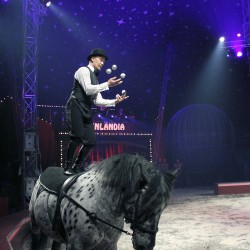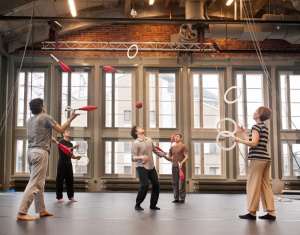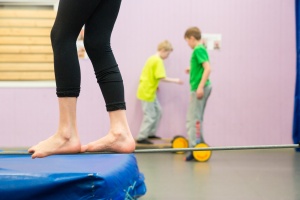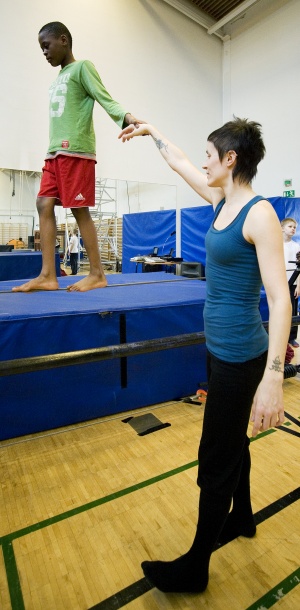Circus culture
| Circus culture |
|---|
| In the national inventory |
Practitioners and people who know the tradition well
The circus culture includes practising circus skills and giving performances. Performances are staged by both amateurs and professionals. Circus shows have hundreds of thousands of spectators in Finland every year.
In addition to circus artists, staging performances also includes professionals of many other fields; they participate in the artistic planning of the show or take care of tasks related to issues such as programming, stage technics and contact with the audience. The circus culture also includes the maintenance, use and development of equipment and the care and training of circus animals.
The Finnish circus professionals consist of roughly three to five hundred persons. In addition to a career as a performer employment is mainly found in teaching circus skills. According to a survey by EU commission “Situation on the Circus sector in the EU Member States” (2019) the circus sector in Finland consists of 426 professionals.
The circus artists have either studied at Finnish and foreign circus schools, or they are self-taught. In addition to contemporary circus companies and classical circuses, they work at private and public events, other performing arts productions and various tasks in variety entertainment. Many also teach at youth circuses and clubs.
Approximately 10,000 hobbyists of different ages practice circus skills in the numerous youth circuses in Finland, and their numbers are growing continuously.
Experts in the circus sector also include the many enthusiasts and circus researchers and collectors, who record circus history and pass on knowledge about the circus.
Practising of the tradition

Finland is a dynamic European circus country. The Finnish circus culture includes touring circus activities with animals and tents, activities of the contemporary circus field, and hobby activities. Circus as a hobby began in the 1970s, and it has led to a unique development of contemporary circus culture in our country. At the same time, touring tented circuses support the vitality of traditional Finnish circus culture in parallel with these activities. The contemporary circus brings circus art to new stages and into new formats.
However, the field of operation of individual circus artists is wider than the three aspects presented here. Circus artists can perform in a great variety of contexts and events. In addition, many people coming from outside the circus culture practise circus skills professionally; therefore, the knowledge and practice of circus art is not only limited to the circus community.
Circus has always been an international art form that crosses boundaries both artistically and geographically. Touring has traditionally been a natural way to reach new audiences. Learning circus skills takes a long time, so the most economical way has been to use the same act or repertoire to reach new audiences in different places. Even today circus has a very international field of operation. The skills, as well as the artists and shows, move from one location and country to another.

A classical circus relies on traditions, and the show consists of acts with a set length that are performed in the ring. The programme can include acrobatic acts requiring skill and body control, different kinds of acts that need precision and manipulation skills, clownery, and magic. Animal acts have a natural role in the classical circus. The orchestra and the ringmaster who presents the show also plays an important role.
In contemporary circus shows, the elements and techniques of circus are used, but the format of the performance is free. Contemporary circus combines circus with other performing arts and uses aesthetics that usually starts from a point closer to performing arts other than the traditional circus. What the performers want to convey with the circus skills is often more important than the trick itself. In the contemporary circus, the location of the performance or the way it is done does not define whether the performance is seen as circus or not.

Like in other performing arts, the aesthetics and forms of circus change constantly. The terminology used also changes along with the art, and the choice of terms depends on their user. The division between classical and contemporary circus reflects the change that started in Europe in the 1970s when the profession of a circus artist opened up to people from outside the traditional circus families with the establishment of circus schools.
In Finland, circus art is used in diverse ways, including promoting social inclusion and the well-being of people with special needs. In the social circus, the circus is used as a way of meeting others depending on the participants’ needs and promoting e.g. participation, communality and everyday activities amongst different kinds of groups such as the elderly, asylum seekers, immigrants, psychiatric rehabilitation patients and youth with special needs. New forms of circus activities, like the baby circus, have also been developed in Finland.
The background and history of the tradition

In concrete terms, circus activities can be considered to have begun in Finland when a French equestrian circus group visited Turku in the summer of 1802, even though individual circus artists had visited our country earlier. In the following decades, Finland gained a permanent position as a transit country for foreign circus troupes on their travels between Stockholm and St. Petersburg.
The circus put together by the brothers Ducander in 1896 is considered to be the first Finnish circus. The beginning of the 1900s until World War I was a period of frequent visits by foreign circuses to Finland. The small domestic companies became professional and many Finnish circus artists and groups performed at markets, the biggest public events of the day.
After Finland became independent a tax on entertainment was levied and the visits by foreign circuses diminished. The long distances, harsh winters and the high entertainment tax levied by the state from circuses made it difficult to operate a circus profitably, and the lifetime of many circuses in the early 1900s was short.
Small circuses were an essential part of the programme at funfairs during the 1930s. There were 16 funfairs touring our country at the most. The front funfair with its circus that operated in Karhumäki from 1942 to 1944 held the circus culture afloat during World War II.
After the war people were longing for the circus entertainment. Sirkus Sariola toured the country during 1949–53. Many Swedish and Danish circuses visited Finland during 1940s and 1950s. The visits were conducted by a charity programme that led to the establishment of an amusement park in Helsinki. A circus, a side show theatre and an outdoor stage also operated in the Linnanmäki amusement park since the 1950s. The entertainment tax was abolished finally in 1981.
Circus activities gained strength again, starting from the 1970s. The first youth circus in Finland was established in Hamina in 1972. Sirkus Finlandia started to operate in 1976. Several other circuses were born here in its wake. Today, there are three or four traditional touring circuses active in Finland.
As an art form, the contemporary circus began to develop in Finland in the 1990s, and around 20 full-time contemporary circus companies have been established since the turn of the century. Shows are also produced by a number of working groups, duos and individual artists. Finnish circus artists and companies work in a very international environment, and Finnish circus art is respected internationally.
The popularity of circus as a hobby has expanded the youth circus activities into a network of youth circus schools and circus clubs that covers almost the entire country, and the teaching is directed towards people of all ages. This has established a good foundation for the Finnish circus culture, raising new generations of performers and spectators.
Professional circus education leading to a degree began in Finland in 1994. At the moment, circus professionals are trained in two vocational institutes, in Turku and in Lahti.
In the space of 200 years, once heavily regulated by authorities who considered it somewhat suspect, the circus has grown to become a respected, active and independent discipline. The state cultural administration now fully recognises the important role circus plays in the Finnish arts.
The transmission of the tradition
In the traditional way of thinking, people grow into the circus by being born to a circus and learning the skills and knowledge from previous generations, often within their own family. Today, circus art is taught at youth circuses and vocational institutions. Learning skills independently based on examples found online, such as on YouTube, is also a path to the circus.
Leisure activities at youth circuses and circus clubs are important for nurturing the circus culture. In addition to the circus skills, the multifaceted wordless tradition related to the circus and the experience of communality are passed on in teaching situations. Maintaining and strengthening the communality experienced amongst circus people is important for the preservation of the circus culture. Communality is very much alive in the events of the field, such as youth circus festivals and conventions of specific disciplines.
Basic arts education in circus arts has been given in Finland since 1993. Starting from the autumn of 2016, circus art is also taught in upper comprehensive school and upper secondary school in Tampere.
Amateur communities create a basis for professional activities in many ways. The career of many current Finnish circus artists has started as a hobby, from which they have attained the professional level by going to the international schools in the field. The skills are still learned from masters from the past generations, both at the circus as well as at circus schools.
Every year, a total of 15–20 circus professionals graduate in Finland from two vocational circus schools. The Arts Academy of the Turku University of Applied Sciences has a four-year circus programme as a part of the performing arts degree programme. Salpaus Further Education in Lahti offers a three-year training for circus artists. Further education often takes place in other European professional circus schools.
A key issue for the vitality of circus culture is ensuring that performance activities continue in diverse ways that are accessible to different kinds of publics, and keeping the connection between performance activities and circus as a hobby alive. The organising of circus festivals and events is very important to maintaining circus culture and renewing the art form.
For their part, enthusiasts immersed in circus knowledge who write about the circus on social media and on blogs, as well as collectors with private collections, are also building the circus culture. Publications written about the circus and exhibitions at museums focusing on the circus are other ways of passing on the circus culture.
The Theatre Museum is the museum with national responsibility for performing arts in Finland and has included circus arts in it's acquisition policy since 2019.
In promoting the circus culture, it is essential to record the history of the art form and use the history in its development and renewal. Research and production of information are needed.
The future of the tradition
Circus is popular, and the field has developed dynamically in the recent decades. The statistics on the numbers of performances and audiences show a positive development. Circus also interests spectator groups that many other performing arts do not reach, such as young urban men.
The number of people with circus as a hobby has grown steadily over recent years. Hobbyists are very important to the future of circus culture in Finland. The children and young people of today who have gained a personal connection to circus through their hobby are the decision-makers of the future and can influence how society recognises circus as a form of art.
A solid base of enthusiasts also brings an audience to circus events. It facilitates inviting foreign artists to perform and teach in Finland. Visitors bring new influences to the activities of professionals and amateurs and diversify the field of circus art in our country. Finland has one upper secondary and one higher vocational education programme in circus art, but the study path does not have a way to go further onwards to master’s and doctor’s degrees. The missing education and the small number of domestic work opportunities cause a brain drain of circus artists going abroad.
Circus art enjoys only a low level of public support in relation to the effectiveness and volumes of the art. The professional field of circus should be developed and its structures should be strengthened, so that the students working and graduating in the field could find job opportunities.
The traditional circus has grown over four decades without public support, and it has kept its place as a favourite of families with children. Traditional circuses also bring circus art to areas without many other cultural activities. The general economic situation affects the operation of circuses that rely on the proceeds from ticket sales, and local changes in the job market are visible in the attendance. Other issues important for the future of traditional circuses include animal rights and land use and construction at town centres by municipalities. Sand-covered fields suitable for circus activities are being paved, which makes it more difficult for circuses to ensure that performances are available throughout the country.
The community/communities behind this submission.
Associations
Cirko – Uuden sirkuksen keskus
Circus companies
Classical circuses
Youth circuses
Espoo School of Performing Arts
The Finnish Youth Circus Association and its 45 member organisations: http://snsl.fi/snsl/jasenyhteisot/
Vocational education
Turun ammattikorkeakoulu, Taideakatemia
Lahti Circus School,Salpaus Further Education
Bibliography and links to external sources of information
The Sirkka database on Finnish circus presents artists, teachers, circus companies and shows.
Situation on the Circus sector in the EU Member States
Online material and blogs
Litterature published in Finland:
Aaltonen, Timo & Purho, Markku (toim.): Makiaa magiaa. Viihdetaikuus ja estraditaide. Markku Purho Ky 2002.
Markku Aulanko & Seppo Malinen & Vesa Salo: Akrobaatin elämää tivolissa. Erään akrobaattiryhmän tarina – ja vähän muutakin! Musta Harlekiini Ky 2015.
Aulanko, Markku & Gammals, Björn: Sirkustemppuja palloilla, renkailla ja keiloilla. Otava 1986.
Aulanko, Markku & Nieminen, Kari: Sirkustaitojen käsikirja. Otava 1989.
Aulanko, Markku: Vanni. Suomalaisen norsuhistorian lyhyt oppimäärä. Musta Harlekiini 2005.
Cedercreutz, Emil: Cirkusliv i Norden. Illustrerad med skulpturer och silhueltter av författaren. Förlaget Bro. Helsingfors 1946.
Heinonen, Pentti: Jalat tukevasti ilmassa. Minerva Kustannus Oy. 2004.
Hirn, Sven: Sirkus kiertää Suomea 1800-1914. Suomalaisen kirjallisuuden seura 1982
Hirn, Sven: Kaiken kansan huvit. Tivolitoimintaamme 1800-luvulla. Suomalaisen kirjallisuuden seura 1986.
Kakko, Sofia-Charlotta & Kekäläinen, Katri (toim.): "Siellä on suupielet korvissa". Hyvinvointivaikutuksia sosiaalisesta sirkuksesta. Tutkivan teatterityön keskuksen julkaisu. Tampereen yliopisto. 2013.
Kakko, Sofia-Charlotta & Kekäläinen, Katri (ed.): "They're smiling from ear to ear". Wellbeing Effects from Social Circus. Publication on the Centre for Practise and Research in Theatre. University of Tampere. 2013.
Kakko, Sofia-Charlotta & Kekäläinen, Katri (toim.): Opas sirkuksen hyvinvointivaikutusten tutkimukseen. Tutkivan teatterityön keskuksen julkaisu. Tampereen yliopisto. 2013.
Kakko, Sofia-Charlotta & Kekäläinen, Katri (ed.): A Guide to the Study of the Wellbeing Effects of Circus. Publication on the Centre for Practise and Research in Theatre. University of Tampere. 2013.
Lehtonen, Eeva-Liisa; Hirn, Sven & Vaisto,Erkki: Sirkus, tivoli ja sirkustemput. Kirjallisuutta 1945-1987. Sirkus ja varieteetaiteen ystävät CiVa 1988. Leivo, Seppo & Leivo, Osmo (toim.) Zeppo Nievo ja muu elämäni. Books on Demand Gmbh, Helsinki 2012.
Lillqvist, Katariina: Arvoisa Herra Tarzan. Balladi viimeisestä eläintenkesyttäjästä. Atena-kustannus 2005.
Maukola, Riina (toim.): Rotta vai tarua. Tanssiteatteri Hurjaruuth. Like 2006.
Mikkanen Raili, Valojärvi Laura: Mennään sirkukseen. Minervakustannus 2012.
Mäkelä, Solmu: Suuri Taikakirja. WSOY 1974.
Nevala, Heikki: Silmänkääntäjiä, konstiniekkoja ja loihtutaiteilijoita. Suomalaisen Kirjallisuuden Seura 2011.
Nevala, Heikki (toim.): Suomen Taikapiiri since 1945. Suomen Taikapiiri ry 2007.
Nevala, Heikki: Huvielämän kiertolaisia. Kotimainen sirkus ja tivolitoiminta 1900-1950. Keravan museo ja Sirkuksen tiedotuskeskus. 2015.
Pakarinen, Petri: Sorin Sirkus: kaksi vuosikymmentä. Tampere, Sorin sirkus, 2006.
Purovaara, Tomi: Ihmeen väkeä! Suomalaisen sirkuksen sankaritarinoita. Like 2008.
Purovaara, Tomi: Nykysirkus. Aarteita, avaimia ja arvoituksia. Cirko – Uuden sirkuksen keskus. Like 2005.
Sándor Kleinbarth, Edit: Balleriina hevosen selässä. [Edit Sandor Kleinbarth: Tibo Trading]. 2007.
Sirkuskirjallisuutta 1945-1994. 100 vuotta suomalaista sirkusta 1896-1996. CiVa-Uutiset 2/96.
Suurenmoinen sirkus. Tekstejä sirkuksesta. Teatterimuseo 2004.
Taivalsaari, Eero: Sirkuselämää. Suomalainen sirkus kautta aikojen. Otava 2006.
Toivonen Katja (toim.): Haminan Teinisirkus. Painoviestintä 2008.
Tyni, Tatu: Taikuuden oppikirja. Motion Magic –liiketaikuus. Like 2004.
Vienonen, Tanja: Painovoimaa uhmaten – Sirkusakrobatian keskeinen termistö suomi – englanti. Pro gradu – tutkielma. Englannin kieli, kääntäminen ja tulkkaus. Kieli- ja käännöstieteiden laitos. Turun yliopisto, 2015.
Yhtä Sirkusta. Muistoja sirkuksesta. Turun maakuntamuseo 2002.
